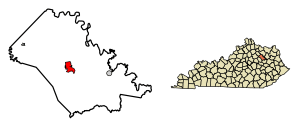Owingsville, Kentucky facts for kids
Quick facts for kids
Owingsville, Kentucky
|
|
|---|---|

Downtown Owingsville
|
|

Location of Owingsville in Bath County, Kentucky.
|
|
| Country | United States |
| State | Kentucky |
| County | Bath |
| Established | c. 1811 |
| Incorporated | 1829 |
| Named for | Thomas Dye Owings |
| Government | |
| • Type | Mayor and City Council |
| Area | |
| • Total | 2.53 sq mi (6.57 km2) |
| • Land | 2.51 sq mi (6.51 km2) |
| • Water | 0.02 sq mi (0.06 km2) |
| Elevation | 892 ft (272 m) |
| Population
(2020)
|
|
| • Total | 1,593 |
| • Estimate
(2022)
|
1,587 |
| • Density | 634.16/sq mi (244.80/km2) |
| Time zone | UTC-5 (Eastern (EST)) |
| • Summer (DST) | UTC-4 (EDT) |
| ZIP code |
40360
|
| Area code(s) | 606 |
| FIPS code | 21-58710 |
| GNIS feature ID | 2404450 |
Owingsville is a city in Bath County, Kentucky, in the United States. It's the main town, also called the county seat, for Bath County. About 1,593 people lived there in 2020. Owingsville is located near the middle of the county, where two important roads, US 60 and Kentucky 36, meet. It is part of the Mount Sterling micropolitan area.
Contents
History of Owingsville
Owingsville was founded in 1811. It was named after Colonel Thomas Dye Owings. In 1795, Colonel Owings came to Kentucky from Maryland. He helped start some of the first iron factories in the area.
Colonel Owings became very wealthy and owned a lot of land. He teamed up with Colonel Richard H. Menefee to create a new community. They decided to name the town after the person who could build the best house the fastest.
Colonel Owings won this friendly competition. He spent $60,000 on his house, which was a lot of money back then! Because he won, the town was named Owingsville.
Geography of Owingsville
Owingsville covers a total area of about 6.2 square kilometers (2.4 square miles). Most of this area is land. A small part, about 0.06 square kilometers (0.02 square miles), is water.
Population and People
| Historical population | |||
|---|---|---|---|
| Census | Pop. | %± | |
| 1830 | 241 | — | |
| 1840 | 251 | 4.1% | |
| 1860 | 480 | — | |
| 1870 | 550 | 14.6% | |
| 1880 | 773 | 40.5% | |
| 1890 | 763 | −1.3% | |
| 1900 | 958 | 25.6% | |
| 1910 | 942 | −1.7% | |
| 1920 | 781 | −17.1% | |
| 1930 | 933 | 19.5% | |
| 1940 | 948 | 1.6% | |
| 1950 | 929 | −2.0% | |
| 1960 | 1,040 | 11.9% | |
| 1970 | 1,381 | 32.8% | |
| 1980 | 1,419 | 2.8% | |
| 1990 | 1,491 | 5.1% | |
| 2000 | 1,488 | −0.2% | |
| 2010 | 1,530 | 2.8% | |
| 2020 | 1,593 | 4.1% | |
| 2022 (est.) | 1,587 | 3.7% | |
| U.S. Decennial Census | |||
In 2020, about 1,593 people lived in Owingsville. The population density was about 244 people per square kilometer.
The people in Owingsville are of different ages. About 21% of the population is under 18 years old. About 26% of the people are 65 years old or older. The average age in the city is 43 years old.
Education in Owingsville
Owingsville has a public library for its community. It is called the Bath County Memorial Library. This library helps people learn and read.
Arts and Culture
Every year, the people of Bath County celebrate with the May Day Pageant. This event is a special tradition that started in 1954. High school seniors can take part in the pageant. They compete for the title of "Miss Bath County." It is a much-loved event in the community.
Notable People from Owingsville
- George Nicholas Bascom (1830–1869), an officer in the U.S. Army. His actions led to the start of the Apache Wars.
- John Bell Hood (1831–1879), a general for the Confederate side during the American Civil War. His troops suffered many losses in the Battle of Franklin.
- Andrew Trumbo (1797–1871), a politician who represented Kentucky in the United States Congress.
See also
 In Spanish: Owingsville (Kentucky) para niños
In Spanish: Owingsville (Kentucky) para niños


